Are penguins endangered? This question must have arisen in your mind whenever you looked at the cute and cuddly penguins in a zoo or on the television. Well, the answer is not that simple. According to the International Union for Conservation of Nature (IUCN), there are five species of penguins that are facing extinction and seven species are listed as vulnerable. The remaining species of penguins are at different levels of endangerment.
What Are Endangered Species?
In modern times, extinction is a real risk for many species of animals because of increasing human involvement in their habitat and way of living. The impact of human activity has also affected penguins that live in some of the remotest areas of the planet. The International Union for Conservation of Nature (IUCN) keeps track of species that are endangered or near extinction.
Sadly, many species of penguins are also endangered as they are on this list with varying levels of threat to their existence. While five of the penguin species are listed as Endangered (EN) some species are listed as Vulnerable (VU), and others are listed as Near-Threatened (NT).
The indiscriminate hunting of penguins in the early 19th century coupled with the slow breeding cycles of penguins has put the existence of these birds in jeopardy. The rising sea levels and global warming also impact the penguin population as the birds are not able to mate, breed, and naturally care for their chicks.
Which Are the Endangered Penguin Species?
There are five major penguin species that are termed as endangered by IUCN. Let’s take a quick look at these species.
1) Northern Rockhopper Penguin (Eudyptes moseleyi)
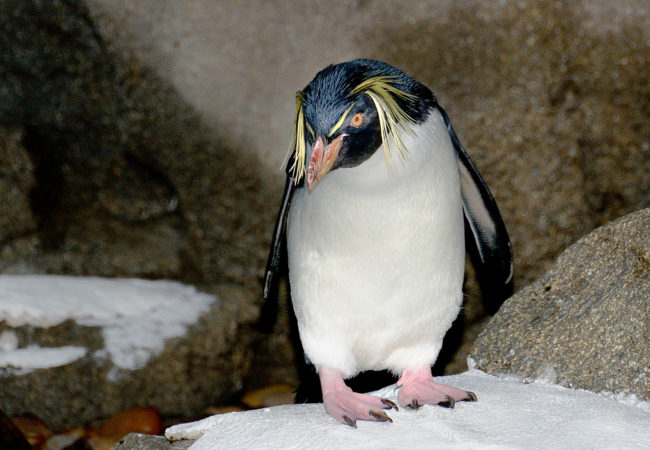
Northern Rockhopper Penguin
The northern rockhopper penguin is one of the smaller penguins with weight ranging from 2.5 to 3 kilograms and length approximately 52 centimeters. This penguin is known for being aggressive and it will peck anything that comes too close to it.
One reason why this penguin species is endangered is that it has a restricted breeding range of seven islands. The total area of these islands is just 250 sq. km. Over 1 million of these birds have disappeared in the past decades because of commercial fishing, predation, and pollution caused by ecotourism.
2) Erect-Crested Penguin (Eudyptes Sclateri)
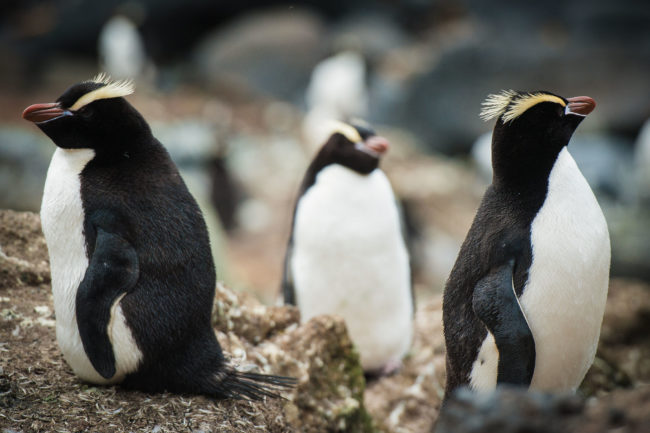
Erect-Crested Penguin
The erect-crested penguin is named so because of its brush-like crested feathers that start from the bill and end at the top of the head. The presence of this crest gives the penguin the appearance of having large eyebrows. The penguin can also move these crest feathers to show aggression or impress the females during mating season.
The average weight of these penguins is 4 kg and they grow up to 60 cm in height. One reason why these penguins are termed as dangerous is because of their small breeding range that is limited to only two locations.
3) Yellow-Eyed Penguin (Megadyptes Antipodes)
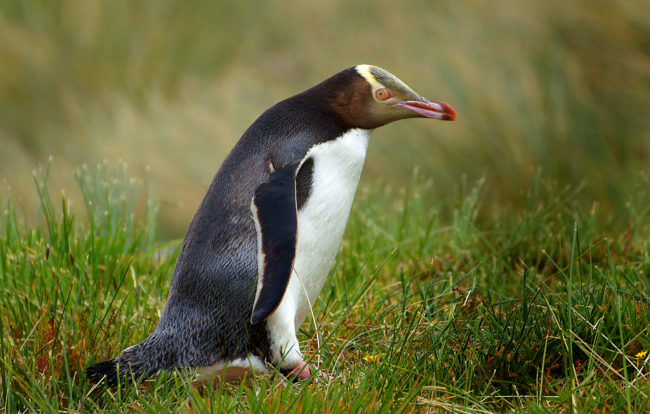
Yellow-Eyed Penguin
This species of penguin is tall and heavy. The distinctive feature is a pale yellow band of feathers that cover the nape and go around the eyes. With an average weight of 5 kgs and length 65 cms, these penguins are mostly found in New Zealand.
These penguins are found in the geographic areas of South Island and Auckland and Campbell Islands. The threats that have caused yellow-eyed penguins to be endangered are the loss of habitat due to human interference such as tourist activity that leads to low reproductive success. The penguin chicks are often predated upon by cats, ferrets, and stoats that leads to reduced survival rates.
4) African Penguin (Spheniscus Demersus)
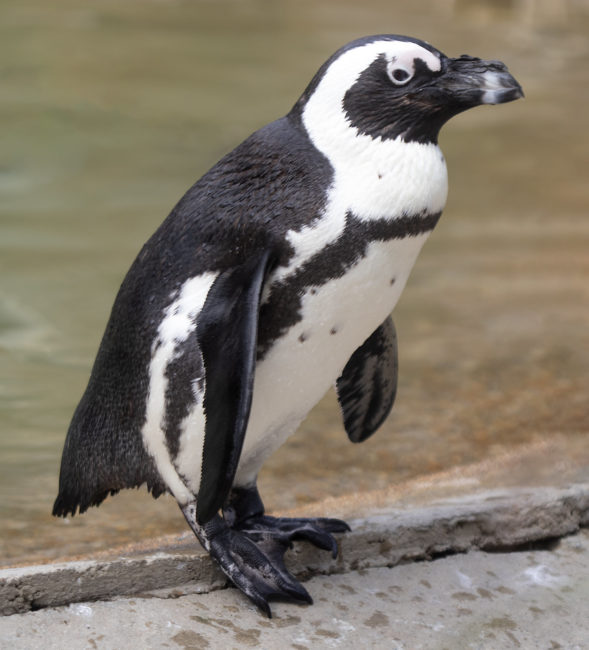
African Penguin
The African penguin is also known as Black-footed penguin or Jackass penguin. This penguin grows up to be 60-70 cms in height and weighs between 3-4 kgs. The unique fact about this penguin is that it is one of the only species to breed in Africa and it is found largely in the areas near Southern Africa.
The nutrient-rich waters of on the South African costs. The penguin mainly feeds on fish which comprises 80% of its diet. The common threats to this species of penguin are oil spills and an irregular breeding pattern.
5) Galapagos Penguin (Spheniscus Mendiculus)
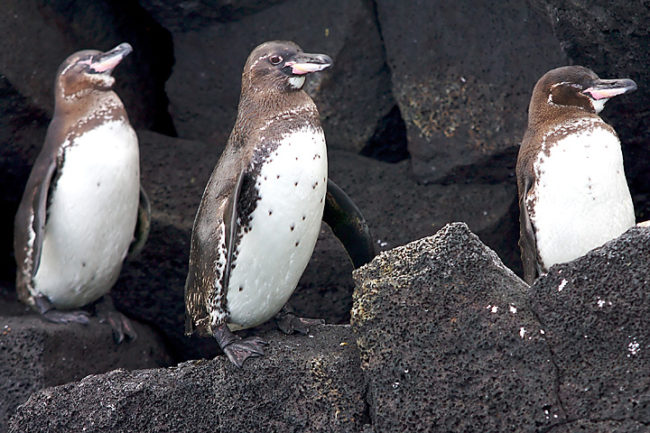
Galapagos Penguin
This species of endangered penguin is the only species that is found North of the equator in the Galapagos islands. The penguin weighs 2.5 kilograms on an average and grows up to 49 centimeters. The breeding pattern of these penguins is dependent on climate, and adverse climate can lead to an unfavorable breeding session.
One reason for this penguin’s endangered status is an El Nino event in 1982 that wiped out 77% of the population of Galapagos penguin. The species has been trying to recover from the effects of that event and the current population of these penguins is around 2000.
Why Are Penguins Endangered?
There are several reasons why penguins are endangered and all these reasons contribute to the level of extinction risk that penguins are facing. Here are some of the reasons why penguins are at risk.
1) Global Warming
Global warming is one of the major risk factors that is creating adverse conditions for penguins. As water levels in the Antarctic region rise, there is less ice and snow which further leads to low availability of food for many animals, including penguins.
Two penguin species that face maximum risk from global warming are Emperor penguin and Adelie penguins. These two species depend on the sea ice to hunt for food and build their nests. With less availability of ice, their habitat is in definite danger.
2) Human Interference
Human activity is one of the primary reasons for the risks posed to penguins. As humans interfere with penguin habitat, the habits of the penguins change in terms of feeding or looking out for danger from other animals. If penguins are fed food by tourists, it can impact their metabolism and natural hunting abilities.
3) Oil Spills
In modern times, oil spills have become a cause of concern for penguins as well as other aquatic animals. The oil clings to the skin and feathers of the penguins and prevents them from swimming properly to look for food.
The oil also decreases the insulating and waterproofing properties of the plumage of penguins, and they become susceptible to the effects of freezing water. Oil can also enter the body of the penguins and harm the internal organs.
4) Excessive Fishing
An increase in fishing in areas where penguin populations exist can contribute to a decrease in food availability for the penguins. Often, different penguin species prefer particular types of fish for sustenance, and if these fish are not available, penguins can often starve to death while looking for other food sources. Overfishing of Anchoveta and Krill can adversely impact the penguin population in the area.
5) Contamination
There are several factors that lead to contamination of the waters where penguins swim and hunt for food. Plastic waste, chemicals, trash is thrown in the water can be life-threatening for penguins who often mistake the trash for food. The presence of pesticides in the water can lead to sickness, reproductive problems and even death among the penguins.
Efforts Made to Save Endangered Penguins
1) Zoological Parks
As most people do not get to observe penguins in the wild, zoological parks can offer a great opportunity to view these magnificent birds in close proximity. This can also help to educate and inform visitors about the endangered status of penguins. The zoological parks also act as sanctuaries for penguins that are endangered.
2) Protected Status
All species of penguins are given protected status under the Antarctic Treaty. The Treaty ensures that all penguins are protected from harm whether it is hunting of penguins or collecting their eggs. Penguin specimens for scientific collection require a permit from Scientific Committee for Antarctic Research (SCAR)
3) National Parks
Macquarie Island was declared as a sanctuary by the Tasmanian government in 1919. The island was given the status of World Heritage site by UNESCO in 1997. The Kerguelen Island, Antarctica were declared a National Park by the French government in 1924. Sydney Harbour National Park in New South Wales mainland also runs a penguin protection program for Manly Little Penguins.
4) Environmental Protection Programs
Penguins are often at risk from natural predators like cats, dogs, and foxes. Efforts are underway in places like Phillip Island Nature Parks to remove natural predators and rehabilitate the endangered penguins to their natural environment. Similar protection plans are in effect by
Conclusion
The answer to the question are penguins endangered is a resounding yes. If not for the efforts of penguin conservationists, the population of these wonderful birds will continue to decline. While only five species of penguins are classified as endangered right now, there is a possibility that the species that are Vulneration or Near-Threatened might also enter the Endangered list in the future.
As amazing as these birds are, there needs to be an increased effort for their conservation, and that can only happen through education and information about the endangered state of penguins and the reasons behind it. With continued education and a focused conservation approach, our future generations will also be able to see these magnificent birds.
If you’d like to know more about penguins, please feel free to browse through this website. Do you have any questions regarding the endangered status of penguins? Please share your queries and thoughts in the comment section.
References
https://neotropical.birds.cornell.edu/Species-Account/nb/species/galpen1/conservation
https://www.aza.org/SAFE-african-penguin/
Image Credits:
#are #endangered #faqs #penguins